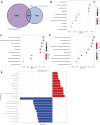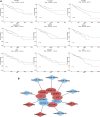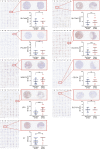Identification and verification of a prognostic signature based on a miRNA-mRNA interaction pattern in colon adenocarcinoma
- PMID: 37745305
- PMCID: PMC10511881
- DOI: 10.3389/fcell.2023.1161667
Identification and verification of a prognostic signature based on a miRNA-mRNA interaction pattern in colon adenocarcinoma
Abstract
The expression characteristics of non-coding RNA (ncRNA) in colon adenocarcinoma (COAD) are involved in regulating various biological processes. To achieve these functions, ncRNA and a member of the Argonaute protein family form an RNA-induced silencing complex (RISC). The RISC is directed by ncRNA, especially microRNA (miRNA), to bind the target complementary mRNAs and regulate their expression by interfering with mRNA cleavage, degradation, or translation. However, how to identify potential miRNA biomarkers and therapeutic targets remains unclear. Here, we performed differential gene screening based on The Cancer Genome Atlas dataset and annotated meaningful differential genes to enrich related biological processes and regulatory cancer pathways. According to the overlap between the screened differential mRNAs and differential miRNAs, a prognosis model based on a least absolute shrinkage and selection operator-based Cox proportional hazards regression analysis can be established to obtain better prognosis characteristics. To further explore the therapeutic potential of miRNA as a target of mRNA intervention, we conducted an immunohistochemical analysis and evaluated the expression level in the tissue microarray of 100 colorectal cancer patients. The results demonstrated that the expression level of POU4F1, DNASE1L2, and WDR72 in the signature was significantly upregulated in COAD and correlated with poor prognosis. Establishing a prognostic signature based on miRNA target genes will help elucidate the molecular pathogenesis of COAD and provide novel potential targets for RNA therapy.
Keywords: RNA therapy; colon adenocarcinoma; miRNAs; prognostic signature; tissue microarray.
Copyright © 2023 Zhao, Li, Li, Guo, Jia, Xu, Chen, Shen and Wang.
Conflict of interest statement
The authors declare that the research was conducted in the absence of any commercial or financial relationships that could be construed as a potential conflict of interest.
Figures





Similar articles
-
MicroRNAs Associated With Colon Cancer: New Potential Prognostic Markers and Targets for Therapy.Front Bioeng Biotechnol. 2020 Mar 10;8:176. doi: 10.3389/fbioe.2020.00176. eCollection 2020. Front Bioeng Biotechnol. 2020. PMID: 32211396 Free PMC article.
-
Comprehensive analysis of microRNA/mRNA signature in colon adenocarcinoma.Eur Rev Med Pharmacol Sci. 2017 May;21(9):2114-2129. Eur Rev Med Pharmacol Sci. 2017. PMID: 28537673
-
Development of a novel necroptosis-associated miRNA risk signature to evaluate the prognosis of colon cancer patients.Ann Transl Med. 2021 Dec;9(24):1800. doi: 10.21037/atm-21-6576. Ann Transl Med. 2021. PMID: 35071494 Free PMC article.
-
Circadian Clock Genes Are Correlated with Prognosis and Immune Cell Infiltration in Colon Adenocarcinoma.Comput Math Methods Med. 2022 Jan 25;2022:1709918. doi: 10.1155/2022/1709918. eCollection 2022. Comput Math Methods Med. 2022. PMID: 35116071 Free PMC article.
-
Identification of prognostic miRNA biomarkers for predicting overall survival of colon adenocarcinoma and bioinformatics analysis: A study based on The Cancer Genome Atlas database.J Cell Biochem. 2019 Jun;120(6):9839-9849. doi: 10.1002/jcb.28264. Epub 2018 Dec 9. J Cell Biochem. 2019. PMID: 30536901
Cited by
-
A novel liquid-liquid phase separation-related gene signature for predicting prognosis in colon cancer.Front Immunol. 2024 Dec 19;15:1514613. doi: 10.3389/fimmu.2024.1514613. eCollection 2024. Front Immunol. 2024. PMID: 39749343 Free PMC article.
-
Single-cell sequencing analysis revealed that WDR72 was a novel cancer stem cells related gene in gastric cancer.Heliyon. 2024 Jul 31;10(15):e35549. doi: 10.1016/j.heliyon.2024.e35549. eCollection 2024 Aug 15. Heliyon. 2024. PMID: 39170171 Free PMC article.
References
LinkOut - more resources
Full Text Sources

